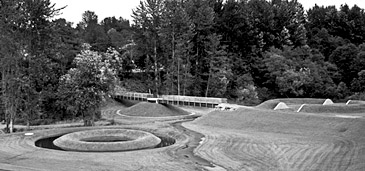
Kent, Washington

Courtesy John Hoge
History
Located south of Seattle, the City of Kent, Washington, is built on the banks of the White and Green Rivers making flooding a constant threat during wet months. Diversion of the White River in the early 1900s and the later addition of a dam in the Green River reduced the severe flood hazard and allowed the town to expand from a predominantly agricultural community to a more industrial, commercial city and major transportation corridor.
In 1979, the King County Arts Commission convened a symposium entitled Earthworks: Land Reclamation as Sculpture, and invited eight artists to create reclamation plans, choosing from more than 100 industrial sites lying fallow in the county. The commission hoped to address the ecological issues at each site while converting the landscapes into usable community spaces through earthwork designs. At that time, the idea of earthworks as a legitimate art medium was seen as both ancient and unassailably modern. Aside from appreciation of pre-historic examples like Stonehenge, the contemporary popularity of land art began with the onset of the environmental movement in the mid-1960s. These earliest earth artists were seeking a new way to employ nature and to transform art. In actively engaging this movement, the King County symposium was groundbreaking and led to the establishment of significant public arts programs in the region as well as across the nation.
The impact of the Earthworks: Land Reclamation as Sculpture series was felt throughout the country, not just in King County. After closing at the Seattle Art Museum, the exhibition traveled across the United States and Canada for more than two years to a dozen major art museums. Previously, public art was confined to large-scale, studio work that did not consider the uniqueness of place or community in which it would eventually be inserted. The symposium helped shift the practice of public art toward a collaborative discipline that explored specificity. The symposium and the Earthworks were instrumental in shifting the concept of Public Art from one of placing discrete works of art in public locations to creating artful public places with strong aesthetic qualities.